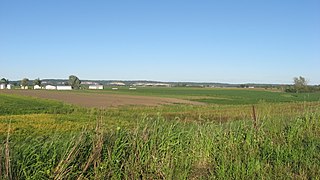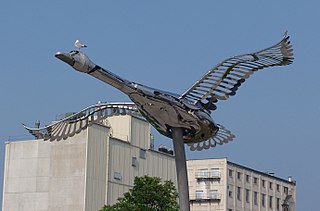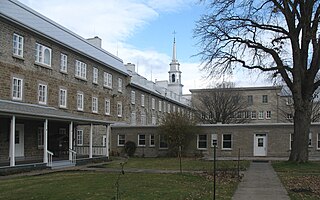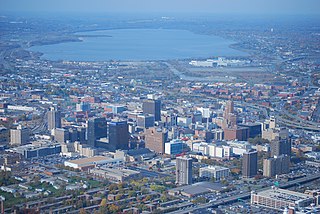 W
WJesuit missions in North America began early in the 17th century, faltered at the beginning of the 18th, disappeared during the suppression of the Society of Jesus around 1763, and returned around 1830 after the restoration of the Society. The missions were established as part of the colonial drive of France and Spain during the period, the "saving of souls" being an accompaniment of the constitution of Nouvelle-France and early New Spain. The efforts of the Jesuits in North America were paralleled by their China missions on the other side of the world, and in South America. They left written documentation of their efforts, in the form of The Jesuit Relations.
 W
WBois Blanc Island, commonly called Boblo Island, is an island in the Detroit River on the Canadian side of the border and is part of Amherstburg, Ontario. The island is about 4.0 kilometres (2.5 mi) long, 0.80 km (0.5 mi) wide and 110 hectares in size.
 W
WFort Charlesbourg Royal is a National Historic Site of Canada in the Cap-Rouge neighbourhood of Quebec City, Canada. Established by Jacques Cartier in 1541, it was France's first attempt at a colony in North-America, and was abandoned two years later.
 W
WChristian Island is a large island in Georgian Bay close to the communities of Penetanguishene and Midland, Ontario. The island, with its neighbours Hope Island and Beckwith Island, is a 5,428.1 hectares Ojibwa reserve, known as Christian Island Indian Reserve No. 30. Together with the 7.5 hectares Christian Island Indian Reserve No. 30A located at Cedar Point, Ontario and the 3.1 hectares Chippewa Island Indian Reserve located in Twelve Mile Sound, 27.5 kilometres (17.1 mi) north of Christian Island, it forms the land base for the Beausoleil First Nation. Christian Islands' highest elevation is 209 metres above sea level.
 W
WGreen Bay is a city in the U.S. state of Wisconsin. The county seat of Brown County, it is at the head of Green Bay, a sub-basin of Lake Michigan, at the mouth of the Fox River. It is 581 feet (177 m) above sea level and 112 miles (180 km) north of Milwaukee. The population was 104,057 at the 2010 census. Green Bay is the third-largest city in the state of Wisconsin, after Milwaukee and Madison, and the third-largest city on Lake Michigan's west shore, after Chicago and Milwaukee. Green Bay is home to the National Football League's Green Bay Packers.
 W
WThe Kahnawake Mohawk Territory is a First Nations reserve of the Mohawks of Kahnawá:ke on the south shore of the Saint Lawrence River in Quebec, Canada, across from Montreal. Recorded by French Canadians in 1719 as a Jesuit mission, it has also been known as Seigneury Sault du St. Louis, Caughnawaga and 17 European spelling variations of the Mohawk Kahnawake.
 W
WKaskaskia is a village in Randolph County, Illinois. Having been inhabited by indigenous peoples, it was settled by France as part of the Illinois Country. Its population peaked at about 7,000 in the 18th century, when it was a regional center. During the American Revolutionary War, the town, which by then had become an administrative center for the British Province of Quebec, was taken by the Virginia militia during the Illinois campaign. It was designated as the county seat of Illinois County, Virginia, after which it became part of the Northwest Territory in 1787. Kaskaskia was later named as the capital of the United States' Illinois Territory, created on February 3, 1809. In 1818, when Illinois became the 21st U.S. state, the town briefly served as the state's first capital until 1819, when the capital was moved to more centrally located Vandalia.
 W
WThe Kolmer Site is an archaeological site in the far southwest of the U.S. state of Illinois. Located near Kaskaskia and Prairie du Rocher in western Randolph County, it lies at the site of an early historic Indian village from the French period. Because it occupies a critical chronological and cultural position, it has been given national recognition as a historic site.
 W
WL'Ancienne-Lorette is a city in central Quebec, Canada. It is a suburb of and an enclave within Quebec City. It was merged with Quebec City on January 1, 2002 as part of a 2000–2006 municipal reorganization in Quebec, but after a 2004 referendum it was reconstituted as a separate city on January 1, 2006.
 W
WMidland is a town located on Georgian Bay in Simcoe County, Ontario, Canada. It is part of the Huronia/Wendat region of Central Ontario.
 W
WMontreal is the second-most populous city in Canada and most populous city in the Canadian province of Quebec. Founded in 1642 as Ville-Marie, or "City of Mary", it is named after Mount Royal, the triple-peaked hill in the heart of the city. The city is centred on the Island of Montreal, which got its name from the same origin as the city, and a few much smaller peripheral islands, the largest of which is Île Bizard. The city is situated 196 km (122 mi) east of the national capital Ottawa, and 258 km (160 mi) south-west of the provincial capital, Quebec City.
 W
WMount Desert Island in Hancock County, Maine, is the largest island off the coast of Maine. With an area of 108 square miles (280 km2) it is the 52nd-largest island in the United States, the sixth-largest island in the contiguous United States, and the second-largest island on the Eastern Seaboard, behind Long Island and ahead of Martha's Vineyard. According to the 2010 census, the island has a year-round population of 10,615. In 2017, an estimated 3.5 million tourists visited Acadia National Park on MDI. The island is home to numerous well known summer colonies such as Northeast Harbor and Bar Harbor.
 W
WNotre-Dame-des-Anges is a parish municipality in Quebec, Canada, home of the General Hospital of Quebec.
 W
WOgdensburg is a city in St. Lawrence County, New York, United States. The population was 11,128 at the 2010 census. In the late 18th century, European-American settlers named the community after American land owner and developer Samuel Ogden.
 W
WPort Royal is a Canadian rural community in Annapolis County, Nova Scotia.
 W
WQuebec City, officially Québec, is the capital city of the Canadian province of Quebec. As of July 2016 the city had a population of 531,902, and the metropolitan area had a population of 800,296. It is the eleventh largest city and the seventh largest metropolitan area in Canada. It is also the second-largest city in the province after Montreal.
 W
WSaint Croix Island, long known to locals as Dochet Island, is a small uninhabited island in Maine near the mouth of the Saint Croix River that forms part of the Canada–United States border separating Maine from New Brunswick. The island is in the heart of the traditional lands of the Passamaquoddy people who, according to oral tradition, used it to store food away from the dangers of mainland animals. The island was the site of an early attempt at French colonization by Pierre Dugua, Sieur de Mons in 1604. In 1984 it was designated by the United States Congress as Saint Croix Island International Historic Site. There is no public access to the island, but there is a visitor contact station on the U.S. mainland and a display on the Canadian mainland opposite the island.
 W
WSaint-François-du-Lac is a community in the Nicolet-Yamaska Regional County Municipality of Quebec, Canada. The population as of the Canada 2011 Census was 1,957. It is located at the confluence of the Saint Lawrence and Saint-François rivers, at the edge of Lac Saint-Pierre.
 W
WSainte Marie among the Iroquois was a 17th-century French Jesuit mission located in the middle of the Onondaga nation of the Haudenosaunee/Iroquois. It was located on Onondaga Lake near modern-day Syracuse, New York. The original mission was in use only from 1656 to 1658.
 W
WSainte-Marie among the Hurons was a French Jesuit settlement in Wendake, the land of the Wendat, near modern Midland, Ontario, from 1639 to 1649. It was the first European settlement in what is now the province of Ontario. Eight missionaries from Sainte-Marie were martyred, and were canonized by the Catholic Church in 1930. Sainte-Marie Among the Hurons was designated a National Historic Site of Canada in 1920. A reconstruction of the mission now operates as a living museum.
 W
WThe Sillery Heritage Site, formerly known as the Sillery Historic District, is a territory containing historic residential and institutional properties, as well as woodlands, located in the Sainte-Foy–Sillery–Cap-Rouge borough of Quebec City, Canada. It is one of four heritage sites which are located in the City of Quebec. Having been called the "cradle of the Quebec nation," it includes approximately 350 buildings situated on a linear 3.5 kilometres wide landscape, which is alongside, as well as an integral part of the coast of the Saint Lawrence River. The built environment was constructed in all of the time periods, including and following the foundation of New France.
 W
WSillery, a former independent city founded in 1637, is one of 35 administrative sectors, which are unincorporated places, located in the post-expansion jurisdiction of the City of Quebec, Quebec, Canada. Sillery was one of multiple self-governing municipalities amalgamated into a vastly expanded Quebec City, that went into legal effect on January 1, 2002, as part of the province-wide 2000–06 municipal reorganization in Quebec. Located alongside in what pre-merger was the southwestern border of Quebec City, Sillery is a constituent district of the borough of Sainte-Foy–Sillery–Cap-Rouge. The territorially expanded City of Quebec consists of six boroughs.
 W
WSyracuse is a city in and the county seat of Onondaga County, New York, United States. It is the fifth-most populous city in the state of New York following New York City, Buffalo, Rochester, and Yonkers.
 W
WTrois-Rivières is a city in the Mauricie administrative region of Quebec, Canada, at the confluence of the Saint-Maurice and Saint Lawrence rivers, on the north shore of the Saint Lawrence River across from the city of Bécancour. It is part of the densely populated Quebec City–Windsor Corridor and is approximately halfway between Montreal and Quebec City. Trois-Rivières is the economic and cultural hub of the Mauricie region. The settlement was founded by French colonists on July 4, 1634, as the second permanent settlement in New France, after Quebec City in 1608. In 2016, the city's population was 134,413.
 W
WVille-Marie is a town on Lake Temiscaming in western Quebec, Canada. It is the largest city and seat of the Témiscamingue Regional County Municipality. As one of the oldest towns in the Abitibi-Témiscamingue region, it is considered the cradle of north-western Quebec and nicknamed "Pearl of Témiscamingue".
 W
WWindsor is a city in southwestern Ontario, Canada, on the south bank of the Detroit River directly across from Detroit, Michigan, United States. Located in Essex County, it is the southernmost city in Canada and marks the southwestern end of the Quebec City–Windsor Corridor. The city's population was 217,188 at the 2016 census, making it the third-most populated city in Southwestern Ontario, after London and Kitchener. The Detroit–Windsor urban area is North America's most populous trans-border conurbation, and the Ambassador Bridge border crossing is the busiest commercial crossing on the Canada–United States border.